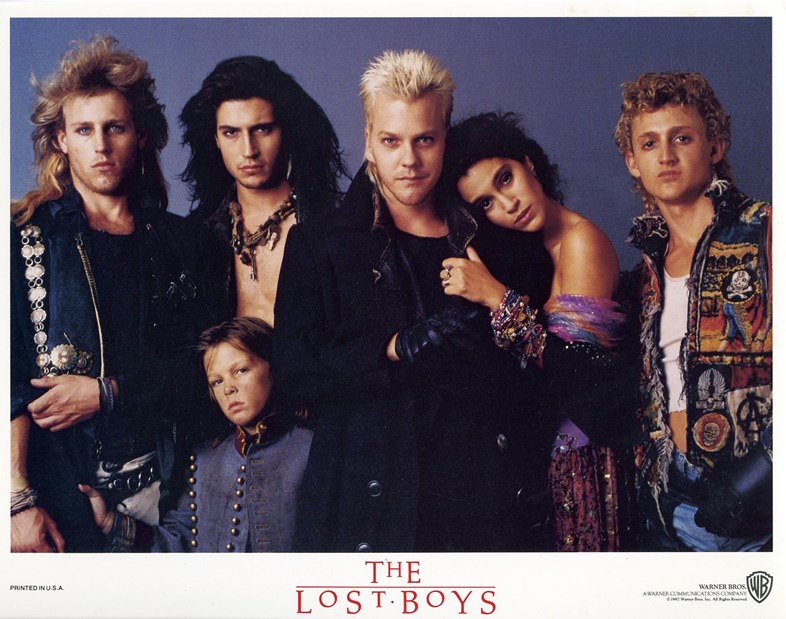In celebration of the film’s 30th anniversary, we look back at Joel Schumacher’s gang of punk vampires
- TextNiall Flynn
Long before Twilight took over tween screens everywhere, Joel Schumacher’s The Lost Boys, released 30 years ago this summer, was the go-to vampire film. Set in a small town in northern California, The Lost Boys was more than just a riotous addition to the 1980s’ now-seminal coming-of-age canon. Young, wild and spearheaded by a 22-year-old Kiefer Sutherland, Schumacher’s vampires were instrumental in dragging cinema’s depictions of the folkloric creature into the 21st century. Three decades on and the film remains one of the first in a swathe of vampire films that culminated in a newer, more desirable model – Robert Pattinson as Edward Cullen.
As a former costume designer, director Schumacher had an acute understanding of the importance of clothing on film. If The Lost Boys’ sharp-jawed adolescence hinted at different kind of on-screen vampire, the way that director and costume designer Susan Becker dressed them amplified it. So, in celebration of the film’s 30th anniversary, we recall five ways in which The Lost Boys helped define ‘bad boy’ style.

1. The all-black wardrobe
Black has come to symbolise many things to fashion: Calvinism in the 16th century, the Romantics in the 19th; and mourning in the Victorian era, to name just a few. The beatniks were the first style subculture to adopt the colour and truly make it their own, but it wasn’t until the punks came along in the 70s – followed by goths and New Romantics – that it took on more rebellious, countercultural associations. It’s little wonder then that in 1987 Schumacher decided to deck Sutherland et al in it. Juxtaposed against the technicolour of the California coastline on which the film takes place, the all-black-wearing cast represent a startling and subversive anomaly.
2. The hair
Would David, played by Kiefer Sutherland, have looked like the mysterious leader of a gang of young vampires without his peroxide mullet? Probably not. Conceived in the 70s and reaching its zenith in the 80s, the mullet had strong associations with rock music – artists Rod Stewart, David Bowie and Andy Mackay of Roxy Music all famously wore their hair in the style, inspiring hordes of imitators. While all of the Lost Boys sport similarly gaudy cuts, David’s bleach blonde number is the pick of the bunch; a perfect combination of otherly, alluring and completely insane.

3. The jewellery
While men have worn earrings throughout history, it wasn't until the 80s that modern Western society really got a hold of them, spearheaded by British musicians such as George Michael. Again, the trend had rebellious connotations and so, when Michael (Jason Patric) starts to wear one – which, incidentally, looks very much like those worn by the late Wham! star – it represents a watershed moment in his metamorphosis from human to vampire. Combined with a quick temper and proclivity for sleeping all day, the earring symbolised adolescent revolt, much as, in The Lost Boys, adolescent revolt symbolised the social deviation of vampirism.
4. The motorbikes
The film’s vampire biker crew, revving up and down the shoreline in the dead of night, are cold, hard proof that a motorbike is the vehicle of choice for any would-be rebel. Part-Hell’s Angels, part-travelling family, pairing the vampire with a motorcycle reinforced its new, alternative depiction as a countercultural staple, and propelled it even further into the modern day.
5. The leathers
The Lost Boys is set in northern California in the middle of a long, hot summer, but that doesn’t stop the vampires from donning sweeping leather coats and jackets as they travel up and down the coast, drinking blood and listening to The Doors. A leather jacket is the outer garment of choise for all serious members of film’s Bad Boy Hall of Fame. Sharp, combative and always in the mandatory black, the crowning piece of The Lost Boys’ look was a nudge to the young, rebellious figures that had come before them, and a wink at their gleeful attempts to reinvent the on-screen vampire. 30 years later, you can judge the success for yourself.











